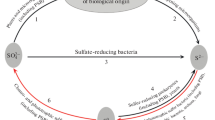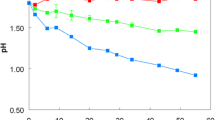Summary
-
1.
The purple sulphur bacteria are able to develop in media containing only one simple, nitrogen-free organic compound, in the absence of oxidizable sulphur compounds.
-
2.
Radiant energy is indispensable for development in these media.
-
3.
A quantitative chemical investigation has been carried out of the metabolism in cultures containing lactate, pyruvate, acetate, succinate, malate or butyrate as the organic substrate.
-
4.
In these cultures practically no metabolic products other than relatively small amounts of CO2 have been detected; in the butyrate cultures CO2 is taken up instead of being formed.
-
5.
By determining the carbon content of the bacterial substance synthesized in the cultures, it has been shown that in all probability the substrate is completely converted into cell material and CO2, i. o. w. that the assimilation predominates in the metabolism.
-
6.
The differences in the amount of CO2 formed (or taken up) per unit of substrate consumed in cultures with different substrates are caused by the different oxidation values of the various substrates, the average oxidation value of the cell material of the bacteria being approximately the same with all substrates.
-
7.
Since a consideration of assimilation in general leads to the insight that the greater majority of organic cell constituents is formed from the substrate via pyruvic acid, the ways in which this acid can be formed from the various substrates used in the experiments have been discussed.
-
8.
The conversion of the substrate into pyruvic acid involves one or more dehydrogenations; a consideration of the hydrogen acceptors which may effect this dehydrogenation shows that CO2 must play a prominent part as an acceptor in this process.
-
9.
In connection with point 2 this leads to the conclusion that photosynthetic processes are involved in the metabolism of the purple sulphur bacteria in organic media.
-
10.
In the equation for photosynthesis in general:
$${\text{CO}}_{\text{2}} {\text{ + }} {\text{2H}}_{\text{2}} {\text{A}} \to {\text{CH}}_{\text{2}} {\text{O}} {\text{ + }} {\text{2A}} {\text{ + }} {\text{H}}_{\text{2}} {\text{O}}$$H2A may now be replaced by organic substances as well as by H2S or H2O.
Similar content being viewed by others
Literature cited
G. Ahlgren, Skand. Arch. f. Physiol. 47, Suppl. 1, 1925.
J. K. Baars, Diss. Delft 1930.
W. Bavendamm, Die farblosen und roten Schwefelbakterien. Jena 1924.
K. Bernhauer, Die oxydativen Gärungen. Berlin 1932.
K. Bernhauer u. W. Stein, Biochem. Zeitschr. 249, 219, 1932.
R. E. Buchanan and E. I. Fulmer, Physiology and Biochemistry of Bacteria, Vol. I. Baltimore 1928.
J. Buder, Jahrb. f. wiss. Bot. 58, 525, 1919.
E. Cahen and W. H. Hurtley, Biochem. J. 11, 164, 1917.
Ph. D. Coppock, V. Subramaniam and T. K. Walker, J. chem. Soc. 1928, p. 1422.
Th. W. Engelmann, Arch. Néerland. 23, 151, 1888.
H. Haehn u. W. Kinttof, Chem. d. Zelle u. Gewebe 12, 115, 1926.
J. Heslinga, Rec. Trav. chim. Pays-bas 43, 551, 1924.
E. W. Hopkins, W. H. Peterson and E. B. Fred, J. of biol. Chem. 85, 21, 1929.
A. W. K. de Jong, Rec. Trav. chim. Pays-bas 19, 259, 1900; 20, 81, 1901; 20, 382, 1901; 21, 191, 1902; 21, 299, 1902; 23, 131, 1904.
H. D. Kay and H. S. Raper, Biochem. J. 16, 465, 1922; 19, 153, 1925.
G. Klein u. O. Werner, Zeitschr. f. physiol. Chem. 143, 141, 1925.
A. J. Kluyver, Arch. f. Mikrobiol. 1, 181, 1930.
Derselbe A. J. Kluyver, The chemical Activities of Microorganisms. London 1931.
A. J. Kluyver u. H. J. L. Donker, Chem. d. Zelle u. Gewebe 13, 134, 1926.
A. J. Kluyver, H. J. L. Donker, u. F. Visser't Hooft, Biochem. Zeitschr. 161, 360, 1925.
F. Knoop, Samml. chem. u. chem.-techn. Vorträge, neue Folge, Heft 9, 1931.
F. Knoop u. H. Oesterlin, Zeitschr. f. physiol. Chem. 148, 294, 1925; 170, 186, 1927.
J. B. van der Lek, Diss. Delft 1930.
H. Molisch, Die Purpurbakterien nach neuen Untersuchungen. Jena 1907.
C. Moritz u. R. Wolffenstein, Ber. d. chem. Ges. 32, 2531, 1899.
C. B. van Niel, Biochem. Zeitschr. 187, 472, 1927.
Derselbe C. B. van Niel, Diss. Delft 1928.
—Derselbe, Arch. f. Mikrobiol. 3, 1, 1931.
C. B. van Niel and F. M. Muller, Rec. Trav. bot. Néerland. 28, 245, 1931.
C. Oppenheimer, Grundriß der Physiologie, Teil I: Biochemie. Leipzig 1925.
J. H. Quastel, Biochem. J. 18, 365, 1924.
—Derselbe, —ebenda 19, 641, 1925.
—Derselbe, —ebenda 20, 166, 1926.
J. H. Quastel and M. Dampier Whetham, —ebenda 18, 519, 1924.
J. Smit, Diss. Amsterdam 1913.
N. L. Söhngen, Diss. Delft 1906.
H. B. Stant, V. Subramaniam and T. K. Walker, J. chem. Soc. 1929, p. 1987.
T. Thunberg, Skand. Arch. f. Physiol. 40, 1, 1920.
P. E. Verkade, M. Elzas, J. van der Lee, H. H. de Wolff, A. Verkade-Sandbergen and D. van de Sande, Proc. Kon. Akad. v. Wetensch. 35, 251, 1932.
S. A. Waksman, Principles of Soil Microbiology. Baltimore 1927.
H. Wieland, Ergebn. d. Physiol. 20, 477, 1922.
Derselbe H. Wieland in C. Oppenheimer, Handb. d. Biochem. d. Menschen u. d. Tiere 2, Jena 1925.
S. Winogradsky, Zur Morphologie und Physiologie der Schwefelbakterien. Leipzig 1888.
—Derselbe, Bull. de l'Inst. Pasterur 29, 679, 1931.
Author information
Authors and Affiliations
Rights and permissions
About this article
Cite this article
Muller, F.M. On the metabolism of the purple sulphur bacteria in organic media. Archiv. Mikrobiol. 4, 131–166 (1933). https://doi.org/10.1007/BF00407535
Received:
Issue Date:
DOI: https://doi.org/10.1007/BF00407535




